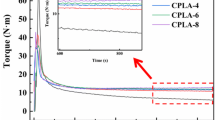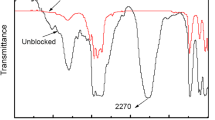Abstract
Solid heat-expandable foam precursors were prepared by impregnating melt-blended poly(d,l-lactide) (PDLLA)-poly(methyl methacrylate) (PMMA) blends with liquid carbon dioxide (CO2). The phase behavior of these blends was strongly dependent on the processing steps, but impregnation with liquid CO2 led to phase separation regardless of the prior thermomechanical history, and crystallization in blends containing a low-D grade of PDLLA suppressed subsequent expansion. On the other hand, blends containing nominally amorphous high-D PDLLA were found to be unstable with respect to expansion under ambient conditions when saturated with CO2. It was therefore necessary to reduce the overall CO2 content by allowing it to desorb partially at 10 °C immediately after impregnation. Under these conditions, the amorphous PDLLA-50 wt% PMMA precursors were stable at ambient temperature and pressure, and showed peak expansion ratios at significantly higher temperatures than pure PDLLA, thanks to the increase in effective glass transition temperature with increasing PMMA content. It was hence demonstrated that blending with PMMA may provide a convenient means of tailoring the process window for heat-expandable polylactide foams, as well as improved heat stability.









Similar content being viewed by others
References
Garlotta D (2002) A literature review of poly(lactic acid). J Polym Environ 9:63–84
Parker K, Garancher JP, Shah S, Fernyhough A (2011) Expanded polylactic acid—an eco-friendly alternative to polystyrene foam. J Cell Plast 47:233–243
Ikada Y, Jamshidi K, Tsuji H, Hyon SH (1987) Stereocomplex formation between enantiomeric poly(lactides). Macromolecules 20:904–906
Rasal RM, Janorkar AV, Hirt DE (2010) Poly(lactic acid) modifications. Prog Polym Sci 35:338–356
Imre B, Pukánszky B (2013) Compatibilization in bio-based and biodegradable polymer blends. Eur Polym J 49:1215–1233
Imre B, Renner K, Pukánszky B (2014) Interactions, structure and properties in poly (lactic acid)/thermoplastic polymer blends. Express Polym Lett 8:2–14
Samuel C, Cayuela J, Barakat I, Müller AJ, Raquez J-M, Dubois P (2013) Stereocomplexation of polylactide enhanced by poly(methyl methacrylate): improved processability and thermomechanical properties of stereocomplexable polylactide-based materials. ACS Appl Mater Interfaces 5:11797–11807
Hirota S, Sato T, Tominaga Y, Asai S, Sumita M (2006) The effect of high-pressure carbon dioxide treatment on the crystallization behavior and mechanical properties of poly(l-lactic acid)/poly(methyl methacrylate) blends. Polymer 47:3954–3960
Eguiburu JL, Iruin JJ, Fernandez-Berridi MJ, Roman JS (1998) Blends of amorphous and crystalline polylactides with poly(methyl methacrylate) and poly(methyl acrylate): a miscibility study. Polymer 39:6891–6897
Shirahase T, Komatsu Y, Tominaga Y, Asai S, Sumita M (2006) Miscibility and hydrolytic degradation in alkaline solution of poly(l-lactide) and poly(methyl methacrylate) blends. Polymer 47:4839–4844
Yao B, Nawaby AV, Liao X, Burk R (2007) Physical characteristics of PLLA/PMMA blends and their CO2 blowing foams. J Cell Plast 43:385–398
Li S-H, Woo EM (2008) Immiscibility–miscibility phase transitions in blends of poly(L-lactide) with poly(methyl methacrylate). Polym Int 57:1242–1251
Li S-H, Woo EM (2008) Effects of chain configuration on UCST behavior in blends of poly(L-lactic acid) with tactic poly(methyl methacrylate)s. J Polym Sci B 46:2355–2369
Canetti M, Cacciamani A, Bertini F (2014) Miscible blends of polylactide and poly(methyl methacrylate): morphology, structure, and thermal behaviour. J Polym Sci B 52:1168–1177
Samuel C, Raquez J-M, Dubois P (2013) PLLA/PMMA blends: a shear-induced miscibility with tunable morphologies and properties? Polymer 54:3931–3939
Velascoa D, Benitoa L, Fernández-Gutiérrez M, San Romána J, Elvira C (2010) Preparation in supercritical CO2 of porous poly(methyl methacrylate)-poly(L-lactic acid) (PMMA-PLA) scaffolds incorporating ibuprofen. J Supercrit Fluids 54:335–341
Yoon Y, Plummer CJG, Thoemen H, Månson J-AE (2014) Liquid CO2 processing of solid polylactide foam precursors. J Cell Plast. doi:10.1177/0021955X14537662
Fischer EW, Sterzel HJ, Wegner G (1973) Investigation of the structure of solution grown crystals of lactide copolymers by means of chemical reaction. Kolloid-Zu Z-Polymer 251:980–999
Brostow W, Chiu R, Kalogeras IM, Vassilikou-Dova A (2008) Prediction of glass transition temperatures: binary blends and copolymers. Mater Lett 62:17–18
Herrera D, Zamora JC, Bello A, Grimau M, Laredo E, Müller AJ, Lodge TP (2005) Miscibility and crystallization in polycarbonate/poly(epsiloncaprolactone) blends: application of the self-concentration model. Macromolecules 38:5109–5117
Breckner MJ, Schneider HA, Cantow H-J (1988) Approach to the composition dependence of the glass transition temperature of compatible polymer blends. Polymer 29:78–85
Lodge TP, McLeish TCB (2000) Self-concentrations and effective glass transition temperatures in polymer blends. Macromolecules 33:5278–5284
Grijpma DW, Penning JP, Pennings AJ (1994) Chain entanglement, mechanical properties and drawability of poly(lactide). Colloid Polym Sci 272:1068–1081
Subramanian V, Samuel Asirvatham P, Balakrishnan R, Ramasami T (2001) Molecular mechanics studies on polypropylene and polymethylmethacrylate polymers. Chem Phys Lett 342:603–609
Chow ST (1980) Molecular interpretation of glass transition temperature of polymer-diluent systems. Macromolecules 364:362–364
Plummer CJG, Yonghoon Y, Garin L, Månson J-AE (2015) Crystallization of polylactide during impregnation with liquid CO2. Polym Bull 72:103–116
Krause B, Diekmann K, van der Vegt NFA, Wessling M (2002) Open nanoporous morphologies from polymeric blends by carbon dioxide foaming. Macromolecules 35:1738–1745
Yu F, Liu T, Zhao X, Yu X (2012) Effects of talc on the mechanical and thermal properties of polylactide. J Appl Polym Sci 125:E99–E109
Bhattacharya S, Gupta RK, Bhattacharya SN (2010) Role of clay in compatibilization of immiscible high melt strength polypropylene and ethylene vinyl acetate copolymer blends. Polym Eng Sci 50:1350–1357
Witt MRJ, Shah S (2008) Methods of manufacture of polylactic acid foams, WO 2008/093284 A1
Gibson LJ, Ashby MF (1999) Cellular solids: structure and properties, 2nd edn. Cambridge University Press, Cambridge
Acknowledgements
We are grateful to the Swiss National Science Foundation for financial support through the program NRP 66 “Resource Wood” and the Interdisciplinary Centre for Electron Microscopy (CIME) of the EPFL for their technical support.
Author information
Authors and Affiliations
Corresponding author
Rights and permissions
About this article
Cite this article
Yoon, Y., Plummer, C.J.G. & Månson, JA.E. Solid heat-expandable polylactide-poly(methyl methacrylate) foam precursors prepared by immersion in liquid carbon dioxide. J Mater Sci 50, 7208–7217 (2015). https://doi.org/10.1007/s10853-015-9275-7
Received:
Accepted:
Published:
Issue Date:
DOI: https://doi.org/10.1007/s10853-015-9275-7




